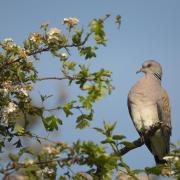In a North Downs Area of Outstanding Natural Beauty, overlooking the Darent Valley, lies a little-known, very precious nature reserve
Fackenden Down’s 14 hectares of high-quality chalk grassland, with areas of scrub and woodland, supports an array of fragrant, pyramidal and man orchids and the nationally scarce early gentian together with characteristic downland insect species, notably butterflies such as brown Argus, chalkhill blue and the rare dark green fritillary.
Originally gifted to us at Kent Wildlife Trust by the owner in 2003, the reserve, a Site of Special Scientific Interest (SSSI), is set to expand significantly thanks to funding from WREN, the Waste Recycling Environmental Ltd.
Three neighbouring fields which total 17 hectares and formerly poor-quality arable land had been managed under the Countryside Stewardship Scheme for 15 years and showed significant improvement in biodiversity in some areas, particularly those close to our SSSI reserve. Encouragingly, species such as fragrant orchid, devil’s-bit scabious and thyme had begun to colonise and spread.
However, in 2013, the Trust discovered that due to changes in levels of subsidy payments on such land, it was no longer proving economically viable for the-then owner, posing a significant threat to these fields with the possibility of them being reverted back to arable production.
Not only that, it also presented a threat to the integrity of the Trust’s existing reserve by sharing a long boundary with an area under intensive production. It would have been tragic to see the gains of 15 years of public investment in improving biodiversity and nature conservation lost in this way.
Then in February this year, good news came in the form of the funding from WREN and, coupled with a very significant donation from a supporter, the Trust has been able to complete the purchase of the fields.
In order to speed up the process of re-colonisation we will be using various techniques to establish chalk grassland species. This will include spreading species-rich green hay on strips of rotavated/disturbed soil; spreading harvested seed; and planting of individual plug plants in specific areas.
We also plan to provide additional fencing and gap up hedges and woodland strips in order to provide corridors for species, such as adder, to move more easily and safely through the site.
Management of these fields will be gradually integrated with the existing reserve by creating connecting gates between the SSSI and the rest of the land. Grazing animals will be able to move freely between the connected sites to encourage the transfer of species between sites.
We will also introduce a programme of monitoring aimed at measuring the progress of restoration and colonisation of key species.
Find out more
Although there is little public access to the majority of the new extension, much of the site can be viewed from the lofty panoramic vantage point of the original reserve which can be found in Fackenden Lane off the A225 between Shoreham and Otford. (TN14 7RS, OS map ref: 188 TQ 531605.)
Please note that there is no facility for car parking at the entrance. However, Shoreham village and railway station is just over one kilometre from the site.
In order to meet the on-going costs of managing the Fackenden Down extension, Kent Wildlife Trust has launched an appeal to raise vital funds. If you would like to donate, please go to www.kentwildlifetrust.org.uk
w



























